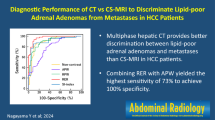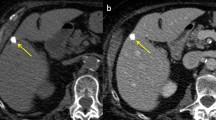Abstract
Objectives
To identify image features of macrotrabecular-massive (MTM) hepatocellular carcinoma (HCC) and to determine its role in predicting MTM-HCC.
Methods
Patients who underwent preoperative gadoxetic acid-enhanced MRI and with surgery proven HCC were retrospectively included. Imaging features were assessed according to Liver Imaging Reporting and Data System. Quantitative measurements were recorded. Clinical characteristics and imaging findings were compared between MTM-HCCs and non-MTM-HCCs. Predictive factors of MTM-HCC were screened with univariate analyses and then identified with multivariate logistic regression. A regression-based diagnostic model was constructed. ROC analyses were used to determine cutoff values, AUC, and corresponding 95% confidence interval (CI) of findings. The diagnostic performance was validated by 10-fold cross-validation.
Results
One hundred and forty-one patients with 37 MTM-HCCs were included. Multivariate analyses identified high platelet count (≥ 163.5 × 103/ul, odds ratio = 3.20; 95% CI: 1.29, 7.96; p = 0.012), low tumor-to-liver ADC ratio (≤ 1.05, odds ratio = 3.05; 95% CI, 1.23 - 7.55; p = 0.016), and necrosis or severe ischemia (odds ratio = 11.61; 95% CI, 3.99 - 33.76, p < 0.001) as independent predictors of MTM-HCC. Necrosis or severe ischemia alone helped identify 86% MTM-HCCs with a specificity of 66%. The average AUCs were 0.81 (95% CI: 0.71, 0.90) for the regression-based diagnostic model, with a sensitivity of 57% and specificity of 92%.
Conclusions
Necrosis or severe ischemia was a sensitive imaging feature of MTM-HCC. Noninvasive prediction of this subtype can be achieved with good accuracy and excellent specificity when findings were combined.
Key Points
• The macrotrabecular-massive (MTM) hepatocellular carcinoma (HCC) represents an aggressive subtype of HCC and is associated with poor prognosis.
• Imaging features of necrosis or severe ischemia alone helped identify 86% MTM-HCCs with a specificity of 66%.
• A regression-based diagnostic model including high platelet count (≥ 163.5 × 10 3 /ul), low tumor-to-liver ADC ratio (≤ 1.05), and necrosis or severe ischemia can provide noninvasive assessment of MTM-HCC with good accuracy and high specificity.




Similar content being viewed by others
Abbreviations
- ADC:
-
Apparent diffusion coefficient
- APF:
-
Alpha-fetoprotein
- AUC:
-
Area under the ROC curve
- CI:
-
Confidence interval
- cv.AUC:
-
Cross-validated AUC
- HBP:
-
Hepatobiliary phase
- HBV:
-
Hepatitis B virus
- HCC:
-
Hepatocellular carcinoma
- LI-RADS:
-
Liver Imaging Reporting and Data System
- MTM:
-
Macrotrabecular-massive
- ROC:
-
Receiver operating characteristic
- SI:
-
Signal intensity
References
Siegel RL, Miller KD (2020) Cancer statistics, 2020. CA Cancer J Clin 70:7–30
Kumari R, Sahu MK, Tripathy A, Uthansingh K, Behera M (2018) Hepatocellular carcinoma treatment: hurdles, advances and prospects. Hepat Oncol 5:Hep08
Portolani N, Coniglio A, Ghidoni S et al (2006) Early and late recurrence after liver resection for hepatocellular carcinoma: prognostic and therapeutic implications. Ann Surg 243:229–235
Uenishi T, Kubo S, Yamamoto T et al (2003) Cytokeratin 19 expression in hepatocellular carcinoma predicts early postoperative recurrence. Cancer Sci 94:851–857
Guan DX, Shi J, Zhang Y et al (2015) Sorafenib enriches epithelial cell adhesion molecule-positive tumor initiating cells and exacerbates a subtype of hepatocellular carcinoma through TSC2-AKT cascade. Hepatology 62:1791–1803
Torbenson MS (2017) Morphologic subtypes of hepatocellular carcinoma. Gastroenterol Clin North Am 46:365–391
Calderaro J, Couchy G, Imbeaud S et al (2017) Histological subtypes of hepatocellular carcinoma are related to gene mutations and molecular tumour classification. J Hepatol 67:727–738
Ziol M, Poté N, Amaddeo G et al (2018) Macrotrabecular-massive hepatocellular carcinoma: a distinctive histological subtype with clinical relevance. Hepatology 68:103–112
Yoneda N, Matsui O, Kobayashi S et al (2019) Current status of imaging biomarkers predicting the biological nature of hepatocellular carcinoma. Jpn J Radiol 37:191–208
Chen J, Wu Z, Xia C et al (2020) Noninvasive prediction of HCC with progenitor phenotype based on gadoxetic acid-enhanced MRI. Eur Radiol 30:1232–1242
Calderaro J, Meunier L, Nguyen CT et al (2019) ESM1 as a marker of macrotrabecular-massive hepatocellular carcinoma. Clin Cancer Res 25:5859–5865
Renne SL, Woo HY, Allegra S et al (2020) Vessels encapsulating tumor clusters (VETC) is a powerful predictor of aggressive hepatocellular carcinoma. Hepatology 71:183–195
Xie Y (2017) Hepatitis B virus-associated hepatocellular carcinoma. Adv Exp Med Biol 1018:11–21
Kumar A, Acharya SK, Singh SP et al (2020) 2019 Update of Indian National Association for study of the liver consensus on prevention, diagnosis, and management of hepatocellular carcinoma in India: the Puri II Recommendations. J Clin Exp Hepatol 10:43–80
Kudo M, Matsui O, Izumi N et al (2014) JSH consensus-based clinical practice guidelines for the management of hepatocellular carcinoma: 2014 update by the Liver Cancer Study Group of Japan. Liver Cancer 3:458–468
Omata M, Cheng AL, Kokudo N et al (2017) Asia-Pacific clinical practice guidelines on the management of hepatocellular carcinoma: a 2017 update. Hepatol Int 11:317–370
Mulé S, Galletto Pregliasco A, Tenenhaus A et al (2020) Multiphase liver MRI for identifying the macrotrabecular-massive subtype of hepatocellular carcinoma. Radiology 295:562–571
Rhee H, Cho ES, Nahm JH et al (2021) Gadoxetic acid-enhanced MRI of macrotrabecular-massive hepatocellular carcinoma and its prognostic implications. J Hepatol 74:109–121
Jeon Y, Benedict M, Taddei T, Jain D, Zhang X (2019) Macrotrabecular hepatocellular carcinoma: an aggressive subtype of hepatocellular carcinoma. Am J Surg Pathol 43:943–948
Zhang L, Yang N, Park JW et al (2003) Tumor-derived vascular endothelial growth factor up-regulates angiopoietin-2 in host endothelium and destabilizes host vasculature, supporting angiogenesis in ovarian cancer. Cancer Res 63:3403–3412
Gerald D, Chintharlapalli S, Augustin HG, Benjamin LE (2013) Angiopoietin-2: an attractive target for improved antiangiogenic tumor therapy. Cancer Res 73:1649–1657
Tsunematsu S, Chuma M, Kamiyama T et al (2015) Intratumoral artery on contrast-enhanced computed tomography imaging: differentiating intrahepatic cholangiocarcinoma from poorly differentiated hepatocellular carcinoma. Abdom Imaging 40:1492–1499
Miura F, Okazumi S, Takayama W et al (2004) Hemodynamics of intrahepatic cholangiocarcinoma: evaluation with single-level dynamic CT during hepatic arteriography. Abdom Imaging 29:467–471
Nishie A, Asayama Y, Ishigami K et al (2014) Clinicopathological significance of the peritumoral decreased uptake area of gadolinium ethoxybenzyl diethylenetriamine pentaacetic acid in hepatocellular carcinoma. J Gastroenterol Hepatol 29:561–567
Hashiguchi T, Arimura K, Matsumuro K et al (2000) Highly concentrated vascular endothelial growth factor in platelets in Crow-Fukase syndrome. Muscle Nerve 23:1051–1056
Aryal B, Yamakuchi M, Shimizu T et al (2018) Deciphering platelet kinetics in diagnostic and prognostic evaluation of hepatocellular carcinoma. Can J Gastroenterol Hepatol 2018:9142672
Funding
This study has received funding from the National Nature Science Foundation of China (Grant Number 81771797) and Science and Technology Support Program of Sichuan Province (Grant Number 2017SZ0003).
Author information
Authors and Affiliations
Corresponding authors
Ethics declarations
Guarantor
The scientific guarantor of this publication is Bin Song (songlab_radiology@163.com, Tel: +86 189-8060-1592, No.37 Guoxue Alley, Chengdu, 610041, China).
Conflict of interest
The authors of this manuscript declare no relationships with any companies whose products or services may be related to the subject matter of the article.
Statistics and biometry
No complex statistical methods were necessary for this paper.
Informed consent
Written informed consent was waived by the Institutional Review Board.
Ethical approval
Institutional Review Board approval was obtained.
Methodology
• Retrospective
• Diagnostic or prognostic study
• Performed at one institution
Additional information
Publisher’s note
Springer Nature remains neutral with regard to jurisdictional claims in published maps and institutional affiliations.
Supplementary information
ESM 1
(DOCX 20 kb)
Rights and permissions
About this article
Cite this article
Chen, J., Xia, C., Duan, T. et al. Macrotrabecular-massive hepatocellular carcinoma: imaging identification and prediction based on gadoxetic acid–enhanced magnetic resonance imaging. Eur Radiol 31, 7696–7704 (2021). https://doi.org/10.1007/s00330-021-07898-7
Received:
Revised:
Accepted:
Published:
Issue Date:
DOI: https://doi.org/10.1007/s00330-021-07898-7




